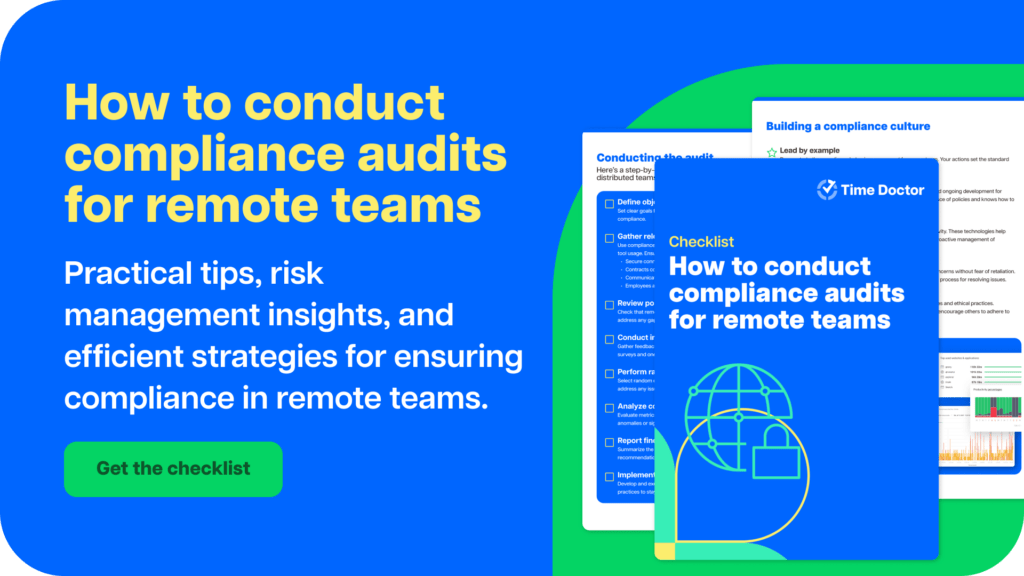Want to know how to measure employee accountability?
If your team’s workload is piling with unfinished tasks, you’re receiving several calls from frustrated customers, or your meetings are transforming into frequent arguments — your organization could be struggling with poor accountability.
So how do you diagnose and fix these problems?
By measuring employee accountability.
In this article, we’ll define employee accountability and highlight how you can measure it. We’ll also share five smart tips to help you create an accountable work environment.

Table of Contents
- What is employee accountability?
- How to measure employee accountability?
- 5 easy ways to improve employee accountability
- Frequently asked questions (FAQ)
Let’s dive right in.
What is employee accountability?
Accountability is the willingness of employees to take responsibility for their decisions, actions, behavior, and performance.
In other words, if an employee says they’ll do something, they’ll follow-through and get it done — no matter the circumstances.
An accountable employee is likely to build trust amongst their team members.
But why should you hold people accountable at the workplace?
Employee accountability at work helps:
- Improve employee performance.
- Boost employee engagement and involvement.
- Increase team morale and satisfaction.
- Create a workplace culture of learning and continuous improvement.
To reap all the benefits, you’ll have to measure accountability to see whether employees are responsible for their work.

How to measure employee accountability?
Measuring accountability doesn’t require tons of empirical research!
Here are five easy to measure team accountability at the workplace:
1. Define accountable behavior
Before you set up an accountability system, you’ll have to define what metrics or behaviors you want to track.
The term ‘accountability’ could refer to outcomes and results. For example, the number of billable hours, the number of deals made, etc.
Accountability could also refer to the repercussions of your team’s poor performance.
For example, you may set monthly sales goals for your team members of around $42,000.
If your team isn’t able to follow-through and reach those organization goals, they would be held accountable and will have to face the consequences.
These could include:
- Not giving them a quarterly bonus.
- Offering them special training.
- Asking them to work overtime to meet their sales objective.
Based on your definition of accountability, you’ll have to set overarching goals for your entire organization.
2. Create SMART goals and measure results
One of the best ways to promote and measure personal accountability is by creating goals for each employee. They’ll have clear expectations of what they’re supposed to achieve and might be more motivated to work.
However, you can’t set just any goal — you’ll have to ensure that it’s a SMART goal.
SMART is an acronym for:
- Specific: Must be written clearly, so they can’t be misinterpreted.
- Measurable: Can be measured with numbers, figures, currency, etc.
- Achievable: Shouldn’t exceed the capacity of an engaged employee or team.
- Relevant: Should align with the core values of the individual or business.
- Time-bound: Should be achieved within a time frame.
Here’s an example of a SMART goal for your team:
‘Increase the number of potential leads by 15% before July 2022.’
With a goal in mind, your team members would know where to focus their efforts, rather than just doing busy work with no fixed purpose.
And you can measure their progress by setting up regular follow up meetings. Or you can have staff members report when they’ve hit a certain milestone.
3. Set up performance metrics
Performance metrics are used to measure how well your team members are doing their jobs.
They also provide hard performance data, which can be used to set benchmarks that employees need to reach. This way, you can motivate employees to boost their own performance.
While you can set objective performance measures like attendance, the number of deals closed, etc., you might have to do a subjective performance evaluation as well.
Evaluate your team on soft skills like leadership, innovation, teamwork, resilience, people management, and contribution to team morale.
Use a rating scale from 1-10 to see how well your employees show these characteristics during a period. Then, you can assign a final rating to the overall performance of each employee based on your previous expectation of them.
This accountability system will help you see which employees can live up to their usual performance standard and which employees need additional training.
4. Hold employee reviews
You may have set SMART goals and performance metrics for your team — but are they really productive?
To test their effectiveness, you’ll have to host an annual performance review for every employee.
Before the review, list down the objectives you had set for each employee last year, their current job role, and their actual outcomes.
During the review, ask your employee how they think they’ve performed. And also, ask them to share the reasons behind the good or bad outcomes.
Based on their responses, you’ll have to determine whether you need to reassess the team member’s responsibilities and duties.
For example, let’s suppose a marketing team member was accountable for addressing customer complaints on Facebook, but they could not do so due to a heavy workload. In this case, you can shift this responsibility to a virtual marketing assistant.
5. Use engagement surveys
Employee engagement surveys are a great alternative to the annual performance review — as they are more personalized and yield deeper insights. Additionally, they help you decode your employee’s feelings towards workplace accountability.
Here are a few questions you can include in your survey:
A. Do you know how your work contributes to our organizational goals?
This survey question addresses accountability at an individual level.
If you receive a lot of negative responses, you might have to:
- Determine whether employees feel that they have control over their work.
- Help them set up a key performance indicator (KPI) that aligns with overall business goals.
B. Do you regularly ask your manager for feedback?
If the answer is mostly yes, you can assume that continuous improvement is one of your organization’s core values.
If the answer is no, you’ll have to investigate why employees are hesitant to ask questions. It could be that they don’t care about their work enough or that they perceive the leadership team as unapproachable.
C. Are you working towards a career plan?
This question helps you identify ambitious employees.
They usually focus on continuous learning and development — which means that they would look for opportunities to take up more responsibility.
D. Do you ask for necessary resources so you can meet goals?
An accountable workplace culture is one where employees can make decisions around their work. If most of the responses are ‘yes,’ your employees proactively request leaders for resources such as software, additional team members, technical training courses, etc.
E. Do you think we hold our leadership team accountable for company performance?
Successful leaders often do what they say.
This is an important question because employees learn by example.
If they feel the managers break the rules and face no consequences for their actions, then the staff members won’t want to hold themselves accountable.
Ideally, these survey questions should reflect what you consider as accountable behavior — allowing your employees to understand what your organization values most.
Here’s how you can effectively interpret survey results and take action based on the responses
How to interpret survey results
- Identify patterns: If you notice consistent negative responses to certain questions, this is a red flag. For example, if a large number of employees respond negatively to a question like, “Do you feel your work contributes to organizational goals?” it indicates a disconnect between their day-to-day tasks and the company’s larger vision.
- Segment responses: Break down the responses by department, team, or even manager. This helps you pinpoint where accountability issues are most prominent. For example, if one department has particularly low scores in areas like feedback or responsibility, it suggests you may need to focus more attention on that team’s processes.
- Compare results over time: If you regularly conduct engagement surveys (quarterly or bi-annually), compare the results over time to see whether accountability has improved or worsened. This will give you insights into whether your accountability initiatives are effective or need to be refined.

5 easy ways to improve employee accountability
Here are a few things you can do to create a culture of accountability within your organization:
1. Address poor performance
It’s natural for employees to make mistakes from time to time.
Here are a few reasons for poor performance:
- Lack of training.
- Poor time management skills.
- Communication issues due to remote work.
- Personal issues that might be affecting work, etc.
Whatever the reason may be, you have to address the issue as soon as possible. If you’re unable to confront the problem, it will only get worse over time.
So what can you do here?
Firstly, remember you need to focus on the performance issue and not the employee.
You’ll have to assume that most team members want to do great work and are not just creating problems on purpose.
Here’s how you should address the employee:
“(employee name) I see that (issue) happened recently. What do you think went wrong here?”
Continue to ask why the team member did the tasks in a certain way.
Some examples of questions include:
- “Did you come across technical difficulties?”
- “Can you walk me through the process you followed, step-by-step?”
- “Would it help if I join your next team meeting?”
By adopting a mindset of curiosity — you can diffuse any tensions that might arise while addressing their mistakes. Additionally, the employee can accept that they have made an error and would be able to fix it based on your feedback.
2. Show empathy
Your employees might not fully understand the impact their behavior has on the rest of the team.
As a manager, you should be kind and find the cause of their behavioral issues and offer solutions.
Let’s assume an individual employee signs out an hour early day — often without finishing their tasks. After speaking to them, you find out that they volunteer for a nonprofit organization after work hours and have to leave early to beat the traffic.
So you’ll have to explain why they need to deliver their work on time.
You can then ask them to either come to work an hour earlier each day or work remotely over the weekend to submit their deliverables. This way, you’ll be able to maintain the team member’s self-esteem by showing your concern for their and your company’s needs.
3. Provide progress updates
After the goal setting process, your employees would need to know if they’re moving in the right direction towards their individual goals.
That’s where progress updates come in.
Use them to provide information and feedback to team members in order to achieve their set goals. Here are a few ways to share updates:
- Use customer or employee surveys.
- Host weekly project update meetings.
- Have one-on-one meetings between employees and managers.
You can even provide updates with the help of project management software. Tools like ClickUp automatically generate status reports that show how many tasks an employee has completed.
4. Reward employees for a job well done
Whenever an employee achieves their goals or goes the extra mile to score deals, sales, etc., don’t forget to reward them for their success.
Let’s take a look at a few innovative reward and recognition systems:
- Offer quarterly bonuses or profit-sharing options.
- Give employees a day or week off.
- Send out gift cards or vouchers.
- Give away free tickets to virtual concerts or shows.
- Ask employees to choose which jobs and responsibilities they’d like to pick up.
- Use social media to publicize an employee’s achievements, etc.
These incentives will motivate employees to work harder and knock it out of the park every time.
Additionally, by offering rewards, you send out a signal that you value your employees greatly. This way, your employees would be less likely to leave to find greener pastures.
5. Use accountability software
While it’s easy to track the performance of one or two staff members, it can be hard to keep tabs on an entire team.
This gets even more complicated when they’re working remotely, as you can’t walk up to their desk to see what they’re working on.
That’s why you’ll need an accountability software.
Accountability software can serve three key purposes:
- Assign tasks, duties, and responsibilities to teams and ensuring that they follow-through.
- Monitor your team’s workplace activities to maintain public employee accountability.
- Provide reports detailing employee metrics such as hours worked, productivity percentages, attendance, etc.
One of the best ways for holding employees accountable is by using Time Doctor.
What’s Time Doctor?

Time Doctor is a robust workforce analytics tool used by huge corporations as well as SMBs. Its powerful features can help in holding employees accountable and boosting productivity across the entire organization.
Here’s a quick peek into how Time Doctor helps improve employee accountability:
- Interactive and automatic timers to track time spent on tasks.
- Create and assign tasks and projects to an employee.
- Comprehensive reports such as activity summary, hours tracked projects and tasks report, etc.
- The ‘Were You Working?’ pop-up prevents employees from logging hours when they were inactive.
- Create shifts and schedules to set work hours for every employee.
- Attendance reports to see which employees are present, absent, or late.
- Screencasts lets you see an employee’s screen activity to see how they spend their work hours.
- 30+ integrations with powerful project management, CRM (customer relationship management), and software development tools.
Wrapping up
Measuring accountability is not rocket science!
All you have to do is to set goals, measure them by using performance metrics and create reports to determine employee efficiency.
If your employees struggle to achieve goals, you can step in and address their performance and provide them with guidance. You can also use accountability software to track and boost your team’s productivity over time.
By following the easy strategies and techniques we covered here, you’ll be able to build a highly efficient and accountable workforce in no time.
software to track and boost your team’s productivity over time.
You can quickly build a highly efficient and accountable workforce by following the easy strategies and techniques we covered here.
Frequently asked questions (FAQ)
1. What are key metrics for measuring accountability?
Some key metrics include:
- Quantitative metrics: Task completion rates, project deadlines met, sales targets achieved, and attendance records.
- Qualitative metrics: Employee feedback, engagement surveys, peer reviews, and evaluations of soft skills like teamwork, leadership, and problem-solving.
2. How can you use accountability software to improve employee accountability?
Accountability software, such as Time Doctor, tracks employee work hours, task completion, and productivity levels. These tools provide real-time data that helps managers monitor employee progress and address performance issues promptly. Features like automatic time tracking and project management tools can help ensure employees meet their goals.
3. What should you do if an employee consistently fails to meet accountability expectations?
If an employee consistently struggles to meet accountability expectations, it’s essential first to identify the root cause. Consider whether they lack the necessary resources, training, or clarity about their responsibilities. Once you identify the issue, offer support, such as additional training or clearer goals. If the issue persists, you may need to reassess the employee’s role or responsibilities.
4. How often should you conduct performance reviews to measure accountability?
Performance reviews should be conducted at least annually, but quarterly reviews are often more effective for tracking progress and addressing issues promptly. Engagement surveys and regular one-on-one check-ins can also help maintain accountability consistently throughout the year.
5. What’s the difference between accountability and responsibility?
Responsibility refers to an employee’s duties and tasks, while accountability is about taking ownership of the results. An employee can be responsible for a project, but accountability means they are answerable for the outcome and whether they deliver the expected results.
6. How can you track accountability in remote teams?
Tracking accountability in remote teams requires using tools like time-tracking software, task management platforms, and regular communication methods like video meetings. Clear expectations, frequent check-ins, and project management tools can help ensure remote employees remain accountable.
This FAQ section will help clarify potential reader concerns and offer additional guidance on implementing accountability measures.

Andy is a technology & marketing leader who has delivered award-winning and world-first experiences.


